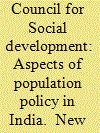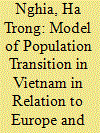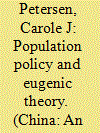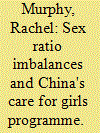|
|
|
Sort Order |
|
|
|
Items / Page
|
|
|
|
|
|
|
| Srl | Item |
| 1 |
ID:
030697


|
|
|
|
|
| Publication |
New Delhi, Council for social Development, 1969.
|
| Description |
xiii, 209p.
|
|
|
|
|
|
|
|
|
|
|
|
Copies: C:1/I:0,R:0,Q:0
Circulation
| Accession# | Call# | Current Location | Status | Policy | Location |
| 008177 | 304.60954/COU 008177 | Main | On Shelf | General | |
|
|
|
|
| 2 |
ID:
048606


|
|
|
|
|
| Publication |
London, Frank Cass, 1997.
|
| Description |
273p.Hbk
|
| Standard Number |
0714647322
|
|
|
|
|
|
|
|
|
|
|
|
Copies: C:1/I:0,R:0,Q:0
Circulation
| Accession# | Call# | Current Location | Status | Policy | Location |
| 040135 | 909.040825/BOO 040135 | Main | On Shelf | General | |
|
|
|
|
| 3 |
ID:
175092


|
|
|
|
|
| Summary/Abstract |
This paper analyses the population transition model for Vietnam, based on Grover’s five stages of population transition. Compatible with the transitional model of Western Europe and other advanced Asian countries, this process in Vietnam has some significant differences: (a) the initial shift or transition of fertility of the population in Vietnam is later than in Asian countries by about 13 years while compared to Europe it is nearly 108 years later; and (b) while the period of initial transition of mortality in Vietnam may not be very different from other Asian countries, it is more than 100 years later than in European countries, especially those in Western Europe. One of the main factors influencing the late transition of Vietnam’s population process is, of course, colonialism and the consecutive wars (1945–1954 and 1955–1975). After 1975, Vietnam’s population was stable as industrialisation and urbanisation led to the development of health services, education and an urban lifestyle, as well as effective population policies.
|
|
|
|
|
|
|
|
|
|
|
|
|
|
|
|
| 4 |
ID:
047018


|
|
|
|
|
| Publication |
Cambridge, Cambridge University Press, 2001.
|
| Description |
xvii, 266p.
|
| Standard Number |
0521662427
|
|
|
|
|
|
|
|
|
|
|
|
Copies: C:1/I:0,R:0,Q:0
Circulation
| Accession# | Call# | Current Location | Status | Policy | Location |
| 044598 | 333.7/O'N 044598 | Main | On Shelf | General | |
|
|
|
|
| 5 |
ID:
095192


|
|
|
|
|
| Publication |
2010.
|
| Summary/Abstract |
The Convention on the Rights of Persons with Disabilities (CRPD) is the first new human rights treaty of the 21st century. China was an early supporter of the CRPD and became East Asia's first State Party in 2008. This article discusses how the CRPD protects the rights of persons with disabilities to life, marriage and procreation, and analyses China's population policy, which continues to reflect eugenic theories. As China did not file any reservations, it is now obligated to reform laws and policies that conflict with the CRPD.
|
|
|
|
|
|
|
|
|
|
|
|
|
|
|
|
| 6 |
ID:
039451


|
|
|
|
|
| Publication |
London, Pemberton Books, 1971.
|
| Description |
xi, 417p.
|
|
|
|
|
|
|
|
|
|
|
|
Copies: C:1/I:0,R:0,Q:0
Circulation
| Accession# | Call# | Current Location | Status | Policy | Location |
| 010624 | 363.9/PAR 010624 | Main | On Shelf | General | |
|
|
|
|
| 7 |
ID:
141099


|
|
|
|
|
| Summary/Abstract |
In China, owing to many parents' preference for sons, the sex ratio at birth (SRB) is imbalanced. During the 2000s, SRB fluctuated at around 120 boys to 100 girls. In the early 2000s, to tackle the SRB imbalance, the Chinese government launched a series of policy measures under the banner of “care for girls.” This article presents a case study of the Care for Girls programme in order to explore how the construction of SRB as a social problem has led to the formulation and adoption of one set of policy responses to the exclusion of others. The analysis shows that the imbalanced SRB has been attributed to rural peoples' cultural and economic deficiencies rather than cast in terms of a need to recognize the inherent worth of girls or a need to ensure that all rural families have entitlements to basic social welfare. This construction of SRB has enabled the Party-state to advance a “care as control” policy response which comprises ideological education, conditional material benefits and sanctions, and which sidesteps the institutional underpinnings of the problem.
|
|
|
|
|
|
|
|
|
|
|
|
|
|
|
|
|
|
|
|
|